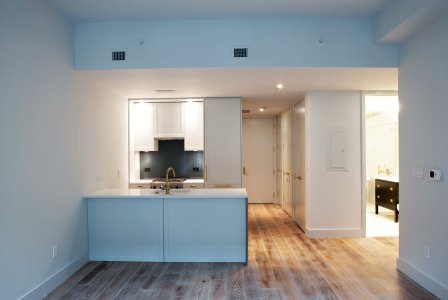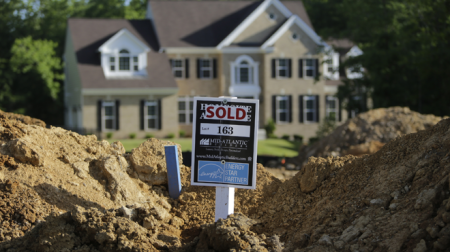
Some condominium developments, like 93 Worth, offer a few one-bedroom units. (Image source: nytimes.com)
For decades, one-bedroom apartments have been a fixture of New York. But finding one going forward, at least in new developments, may become as hard as hailing a cab in a downpour.
Developers convinced that buyers want extra legroom — and often seeking to recoup their own sky-high investments in land — are phasing one-bedrooms out of new buildings in favor of much more spacious units.
“I don’t know that one-bedrooms will ever become extinct,” said Charles R. Bendit, a chief executive at Taconic Investment Partners, “but I think the nature of the city is changing. Young kids aren’t leaving as quickly as they once did, and people who are making an investment are investing in a family home.”
Mr. Bendit is putting his analysis to the test as he develops Sterling Mason, a once-stalled condo at 71 Laight Street in TriBeCa. When conceived during the last real estate boom, by a different developer, the project was to have offered five one-bedrooms out of 36 units, in a complex made up of a new building and a renovated one, side by side.
But after buying the building for $65 million in 2012, Taconic decided that bigger would be better, and it reconfigured the interiors to allow for larger apartments, a process that involved removing two elevator banks and stairways. Today there are no one-bedrooms at Sterling Mason, which has 32 units, 14 of them three-bedrooms.
And the bet may have been a smart one. Since last summer, when sales began, eight of the units have sold, at an average of $2,700 a square foot, according to Streeteasy.com. And “no one is coming in to say, ‘Gee whiz, I wish you had one-bedrooms,’ ” Mr. Bendit added.
Whether to be family-friendlier, or for reasons affecting the bottom line, developers generally appear to be decreasing the supply of new one-bedrooms.
At the start of this month, there were 104 for sale in new condos in Manhattan, out of 654 units in total, or a 16 percent share, according to research from the Corcoran Sunshine Marketing Group.
Over the same time last year, there were 194 one-bedrooms for sale out of 718 units, or a 27 percent share, the data show. Similarly, at the beginning of 2010, there were 463 one-bedrooms on the market, out of 1,798 units, or a 26 percent share.
Even when resale units are taken into account, the one-bedroom market seems a shade of its former self — though of course the shortage bodes well for anyone with a one-bedroom to sell.
Last week, there were 1,227 one-bedrooms for sale in Manhattan, according to Streeteasy.com. The units, mostly south of 110th Street, were listed at a median price of $745,000, or about $1,130 a square foot, the data show. At their peak in December 2008, by contrast, the number of one-bedrooms in Manhattan reached 3,257, according to Streeteasy.
As the recession roiled the market, one-bedrooms encountered strong headwinds; many of the first-time buyers drawn to these starter apartments were unable to get loans, which caused units to linger and dip in price. Since then, in the last couple of years, as the housing and lending markets have improved, one-bedrooms have practically flown off the shelves. Sales, in fact, made up about 41 percent of all deals in the fourth quarter of 2013, according to the Miller Samuel appraisal firm; the quarterly showing was the strongest since 1997, when they represented about 43 percent off all deals.
Given that one-bedrooms constitute such a large portion of the market, one might think developers would want to build more of them. But many developers have had to shell out more for land purchases — in Manhattan, prime lots can cost around $850 a square foot — so there is often pressure to build the larger, more expensive units, said Jonathan J. Miller, the president of Miller Samuel.
“It’s not that there is no demand for one-bedrooms,” he said. “It’s that there is no demand for one-bedrooms at $4,000 a foot, which would make some of these sites feasible.”

A one-bedroom unit at 530 Park Avenue. (Image source: nytimes.com)
The market share of one-bedroom sales is expected to drop further in 2014 as new multi-bedroom products begin to work their way through the system.
The list of condominiums with few one-bedrooms is long and splashy. Walker Tower, the conversion of a former telephone building in Chelsea, on West 18th Street, had just three one-bedrooms out of 53 units. Closings there began in November.
There are only eight one-bedrooms, out of 145 units, at 56 Leonard in TriBeCa, according to a spokeswoman for the Alexico Group, a developer in the project. At One57, the skyscraping condominium from the Extell Development Company on West 57th Street, just eight of 94 units are one-bedrooms, according to a company spokeswoman. Brokers say that one-bedrooms are often used for nannies. But at Walker Tower, which ended up with a total of 47 units in the building, some of the scarce one-bedrooms were combined, according to Michael Stern, the managing partner of the JDS Development Group, which developed the building, along with Property Markets Group.
Even smaller projects are supersizing: the Schumacher, a condo conversion at 36 Bleecker Street in Greenwich Village, has no one-bedrooms among its 20 units, according to its website, though it does have several four-bedrooms.
Still, even though one-bedrooms seem to be fading in importance in the sales market, they are plentiful as rentals, brokers point out. Nor are all Manhattan developers eschewing one-bedrooms, which make sense for some projects’ economics. When they are offered alongside larger units, they can prove more popular, as at 530 Park Avenue, a 109-unit condo conversion on the Upper East Side, at 61st Street. Since last spring, 60 units have sold, 22 of them one-bedrooms, according to Aby J. Rosen, a principal of RFR Holding, its developer. Only three one-bedrooms are left, he added.
In less affluent areas, where land prices are lower, one-bedrooms may be a better fit. At Edgecombe Parc Condominium, a project underway at 456 West 167th Street in Washington Heights, more than half the units, or 27 out of 49, are one-bedrooms. Seventeen have sold since marketing began in November, according to Ilan Bracha, a broker with Keller Williams New York City, which is handling sales. Prices at the building, which is being developed by Gleam Realty, have averaged $700 a square foot, Mr. Bracha said.
Large units in areas like TriBeCa attract families in part because of the top-rated public schools. But in neighborhoods like 530 Park’s, where the schools are not as much of an attraction, family-size units can be a harder sell, said Mr. Rosen, adding that many one-bedroom buyers have said they will use them as pieds-à-terre.
“Everybody is chasing the $50 million buyer,” he said, “but I would rather focus on the $7 million to $10 million buyer.”
Sometimes the sites themselves determine the sizes of units. “You don’t want to bastardize the shape of a building; if it dictates larger apartments, it’s better not to create tiny units,” said Doron Zwickel, a Core Group broker in charge of sales at 93 Worth Street, a 91-unit project in a former textile factory in TriBeCa. “But this was not a very deep building, with lots of windows, so it was very efficient to do.”
At 93 Worth, there are 16 one-bedrooms, or 18 percent of the total, as well as 22 studios; eight units remain for sale after a little over a year of marketing, Mr. Zwickel said. Average sale prices have been $1,850 a square foot.
At a new condo that Mr. Zwickel is marketing at 241 Fifth Avenue, the one-bedroom count is even higher: 35 percent of the listings, or 16 out of 46 units. Only one of the units remains.
“I believe that most of the product in the works is still geared toward the high end and the mega-rich,” he said. “I think it would be wise to create more variety.”













